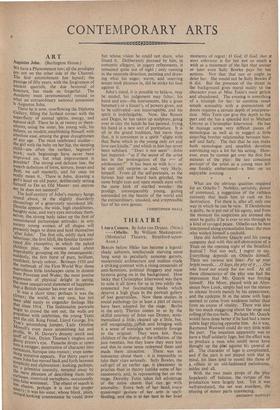CONTEMPORARY ARTS
ART
WE have a Phenomenon too; all the prodigies are not on the other side of the Channel. The first astonishment has lapsed; the Passage of fifty years, with the forgiveness of ancient quarrels, the due bestowal of honours, has made us forgetful. The Academy must. ceremoniously remind us What an 'extraordinary national possession is Augustus John.
There he is now, overflowing the Diploma Gallery, filling the farthest corner with the superfluity of animal spirits, energy, and natural skill. There he is, at twenty or there- abouts, using his sister, his young wife, his infants, as models, establishing Himself, with absolute ease, among the great draughtsmen of any age. The most celebrated studies— the girl with the baby on her hip, the sleeping child—are often the earliest, beginner's work; such beginnings have never been improved on, but what improvement is Possible? The strong and delicate line, the superb definition of form, texture, bones and flesh, we call masterly, and for once we really mean it. There is John, drawing a girl's head on old paper, deliberately setting himself to Do an Old Master: can anyone say he does not succeed? The half-century of John's mastery hangs round about, in the slightly disorderly chronology of a generously unordered life. borelia appears, the wide, high cheekbones, haughty nose, and wary eyes introduce them- selves, the strong body takes up the first of unnumbered picturesque attitudes: in arty society young women of all shapes will Presently begin to dress and hold themselves `after John.' The first oils, oddly dark and laborious; the first Idyll, the familiar fantasti- cated fete champetre, in which the naked children play, the women stand about Improbably gossiping on the mountainside; suddenly, the first burst of pure, brilliant, confident, lovely colour. Between 1910 and the outbreak of the First World War those .marvellous little landscapes came in dozens from Provence and Wales; the most precise expression of physical delight in seeing, the most unequivocal statement of happiness that a British painter has ever set down.
it was a short time; perhaps it was the climax; the world, in any case, has not
able easily to engender feelings like trlatn since 1914. The fashionable portraits populous to. crowd the rest out, the walls are PcPulous with celebrities, the young Yeats ,ncl the old, King Feisal, Lloyd George, Iris r.ee's astonishing jumper, Lady Ottoline morrell's even more astonishing hat and Profile, W. H. Davies's dreamy smirk and tlaiff of hair, Dylan Thomas's ringlets and glassy prawn's eye. Panache drops at times ..,mo a swagger, penetration of character into creature, baroque into rococo ; even some- lag tentative appears. For thirty years or re John has moved back and forth between foinPlieltV and elaboration; looking, perhaps, ,,r a primitive intensity, tempted away by
but whose vision he could not share, who found it. Deliberately pursued by him, in romantic allegory, in sugary refinements, it remained quite out of sight ; only running in the opposite direction, painting and draw- ing what his eager, warm, and unerring senses took pleasure in, did he strike his foot against it.
John's mind, it is possible to believe, may be misled, his judgement may falter; his hand and eye—the instruments, like a great batsman's or a fencer's, of powers given, not to be cultivated—are incorruptible, and his spirit is indefatigable. Now, like Renoir and Degas, he has taken up sculpture, going over in clay the heads he has painted, trying his hand at a new sort of portraiture. It is all in the grand tradition, but more than that,.it is consistent in a spirit "alight with that flame which in the young only art and love can kindle," and which in him has never been subdued. "Does it not seem"—John has inquired—"as if the secret of the artist lies in the prolongation of the P,nr of adolescence?" It has been so with hiin : so he call' still surprise. us and, very likely, himself. From all the self-portraits, as the furious hair and beard turn grizzled, the same bright eyes and open mouth stare with the same look of startled wonder: the prodigy, unconquerably young, gazing astounded on the beauty of the world and the extraordinary, unasked, and irrepressible fact of his own genius.
CHRISTOPHER SMALL


































 Previous page
Previous page